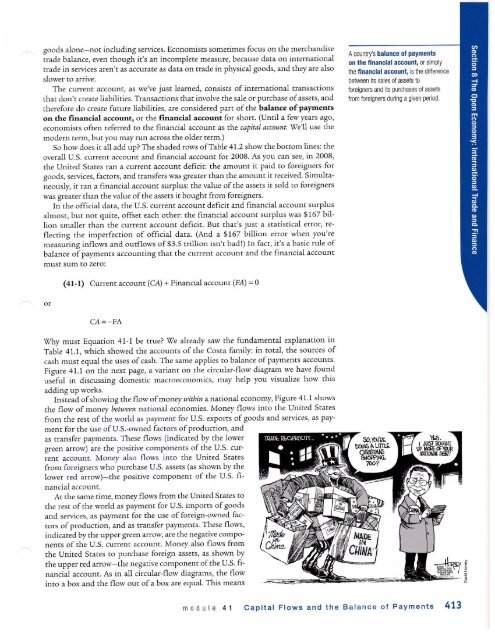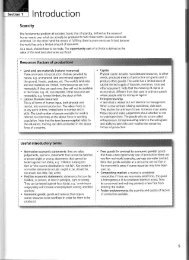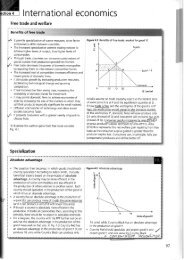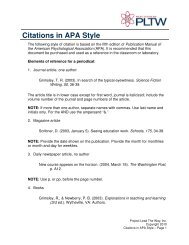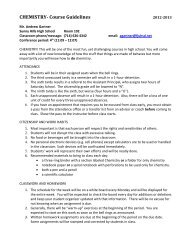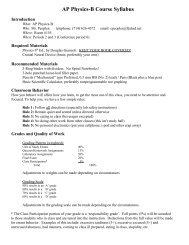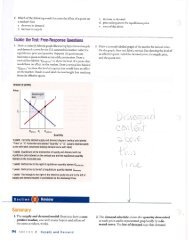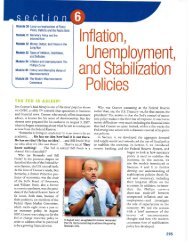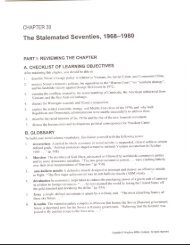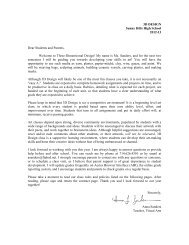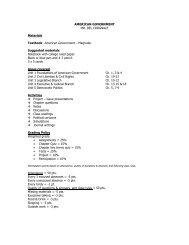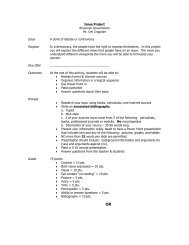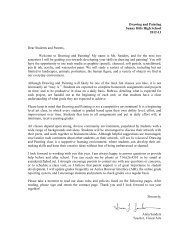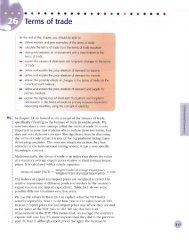AP Econ Module 41 Capital Flows Balance Payments - Sunny Hills ...
AP Econ Module 41 Capital Flows Balance Payments - Sunny Hills ...
AP Econ Module 41 Capital Flows Balance Payments - Sunny Hills ...
You also want an ePaper? Increase the reach of your titles
YUMPU automatically turns print PDFs into web optimized ePapers that Google loves.
goods alone-not including services. <strong>Econ</strong>omists sometimes focus on the merchandise<br />
trade balance, even though iCs an incomplete measure, because data on international<br />
trade in services aren't as accurate as data on trade in physical goods, and they are also<br />
slower to arrive.<br />
The current account) as we've just learned, consists of intemational transactions<br />
rhat dorit create liabilities, Transactions that involve the sale or purchase ofassets, and<br />
therefore do create future liabilities, are considered part of the balance ofpayrnents<br />
on the financial account, or the financial account for short. (Until a few years ago,<br />
economis* often referred to the financid account as tt.e cdPital &co&nt. We'Il use the<br />
modern term, but you may run ac(oss ahe older term.)<br />
So how does it all add up? The shaded rows ofTable <strong>41</strong>.2 show the bottom lines: the<br />
overall U.S. cur:rent account and financial account for 2008. As you can see, in 2008,<br />
the United States ran a cuffent account deficit: the amount it paid to foreigners for<br />
goods, services, factors, and transfers was greacer than the amount it received' Simultaneously,<br />
it ran a financial account surplus: the va.lue ofthe assets it sold to foreigners<br />
was greater than the value ofthe assets it bought from foreigners.<br />
In rhe official data, the U.S. current account deficit and financial account surplus<br />
almost, but not quite, offset each other: the financial account surplus was $167 billion<br />
smaller than the current account deficit. But that's just a statistical error, reflecting<br />
the imperfecdon of official data. (And a $167 billion error when you're<br />
measuring inflows and outflows of$3.5 trillion isn't badl) In fact, it's a basic rule of<br />
balance of payrnents accounting that the current account and the financial account<br />
must sum to zero:<br />
of<br />
(<strong>41</strong>-1) Current account (C.r{) + Financial account (IA) = 0<br />
C.4 = -FA<br />
Why must Equation <strong>41</strong>-1 be true? We already saw the fundamental explanation in<br />
Table 47.1, which showed the accounts of the Costa family: in total, the sources of<br />
cash must equal the uses ofcash. The same applies to balance ofpayments accounts.<br />
Figure <strong>41</strong>.1 on the next page, a varianr on the circular-flow diagram we have found<br />
o""fr.I i.t discussing domestic macroeconomics, may help you visualize how this<br />
adding up works.<br />
Insiead ofshowing the flow ofmoney aitbin anationa\ economy, Figure <strong>41</strong>.1 shows<br />
the flow of money between nrtiond economies Money flows into the United States<br />
from the rest ofthe world as Paym€nt for U.S. exports ofgoods and services, as payment<br />
for the use of U,S.-owned factors ofproduction, and<br />
as ransfer pay'rnents. These flows (indicated by the lower<br />
green arrow) are the Positive comPonents of the U.S. current<br />
account. Money also flows into the United States<br />
from foreigners who purchase U.S. assets (as shown by the<br />
lower red arrow)-the positive component of rhe U.S. financial<br />
account.<br />
At the same time, money flows frorn the United States to<br />
the rest ofthe world as payment for U.S. imports ofgoods<br />
and services, as paymenc for the use of foreign-owned factors<br />
of production, and as transfer papnents. These flows,<br />
indicated by the upPer green alrowJ a(e the negative comPonents<br />
of the U,S, current account. Money a.lso flows from<br />
the United States to purchase foreign assets, as shown by<br />
the upper red arrow-the negative comPonent ofche U.S. financial<br />
account. As in all circular-flow diagrams, the flow<br />
into a box and the flow out ofa box are equal. This means<br />
A country's balance ol payments<br />
on the linancial account, orsimply<br />
the linancial account, is the difference<br />
between its sales of assets to<br />
foreigners and its purchases of assets<br />
from foreigners during a given period.<br />
m 0 d u le <strong>41</strong> capital <strong>Flows</strong> and the <strong>Balance</strong> ol <strong>Payments</strong> 473


